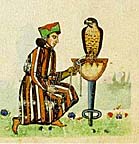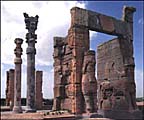 The Daily Star - Arts & Culture - 3500-year-old Bronze Age temple discovered in Jordan
The Daily Star - Arts & Culture - 3500-year-old Bronze Age temple discovered in Jordan: "A 3,500 year old temple from the Late Bronze Age has been discovered at Tall al-Umayri just south of Amman.
The walls and cultic shrine of a temple dating from about 1,500 BC were uncovered at the end of July at the Bronze and Iron Age archaeological site by excavators working for the Madaba Plains Project and the Jordan Department of Antiquities.
Towering 3 meters above the heads of the excavators, the walls of the temple created four rooms. In the largest room, about 5 by 8 meters in size, was a whitewashed niche with a smooth, dome-shaped standing stone in the center flanked by four smaller stones, two on each side.
According to the excavators, the smooth stones of the niche are unlike any other stones at the site and probably represented deities in the ancient world. The large central stone likely indicates the main deity of the temple, while the four other stones suggest associated, but minor deities, perhaps the children of the main god.
The major deity of the region at that time was a god named Il (or El). It is the same word as the Arabic word for God, Allah. To an ancient, Il was the father of the gods, but, stress the excavators, "we do not know for certain who the standing stones represent or the beliefs associated with them."
Within the niche and above the stones to the right the excavators found several ceramic vessels, probably containing votive gifts for the gods."
If you enjoyed this post, never miss out on future posts by following me by email!


 I see archaeologists are once again in a race against time as they try to excavate a site in the Sudan that will be covered by water upon completion of Merowe Dam hydroelectric project:
I see archaeologists are once again in a race against time as they try to excavate a site in the Sudan that will be covered by water upon completion of Merowe Dam hydroelectric project:



 Dating from the Achaemenid era (559-330 BC), Parse consists of a thorough set of structures and relics, including Persepolis, palaces, fences and utility services. It is believed the city was built on the orders of Darius I in 518 BC. Parse in general and Persepolis in particular have been extensively excavated over the last century, though there are many unexplored areas in the site.
Dating from the Achaemenid era (559-330 BC), Parse consists of a thorough set of structures and relics, including Persepolis, palaces, fences and utility services. It is believed the city was built on the orders of Darius I in 518 BC. Parse in general and Persepolis in particular have been extensively excavated over the last century, though there are many unexplored areas in the site.
 The Kerameikos Kouros, unearthed in May 2002, is a striking, 2.10-meter statue of the Archaic era whose beauty, unaltered over 2,500 years, stunned the German archaeologists who found it.
The Kerameikos Kouros, unearthed in May 2002, is a striking, 2.10-meter statue of the Archaic era whose beauty, unaltered over 2,500 years, stunned the German archaeologists who found it.
 Maj. Wayne Bowen, head of the 416th’s Higher Education and Antiquities Team, is working with Ninevah Director of Antiquities, Muzahim Mahmood, to facilitate restoration projects at the Nergal Gate and King Sennacheribe’s palace.
Maj. Wayne Bowen, head of the 416th’s Higher Education and Antiquities Team, is working with Ninevah Director of Antiquities, Muzahim Mahmood, to facilitate restoration projects at the Nergal Gate and King Sennacheribe’s palace.
 "The inexplicable behavior of ravens is reminiscent of avian illness and death weeks before the first human cases of West Nile virus infection were identified in the United States. We posit that Alexander may have died of West Nile virus encephalitis," said Marr and Calisher.
"The inexplicable behavior of ravens is reminiscent of avian illness and death weeks before the first human cases of West Nile virus infection were identified in the United States. We posit that Alexander may have died of West Nile virus encephalitis," said Marr and Calisher.


